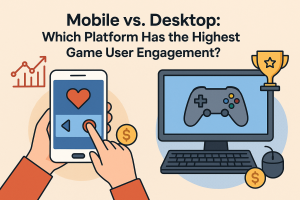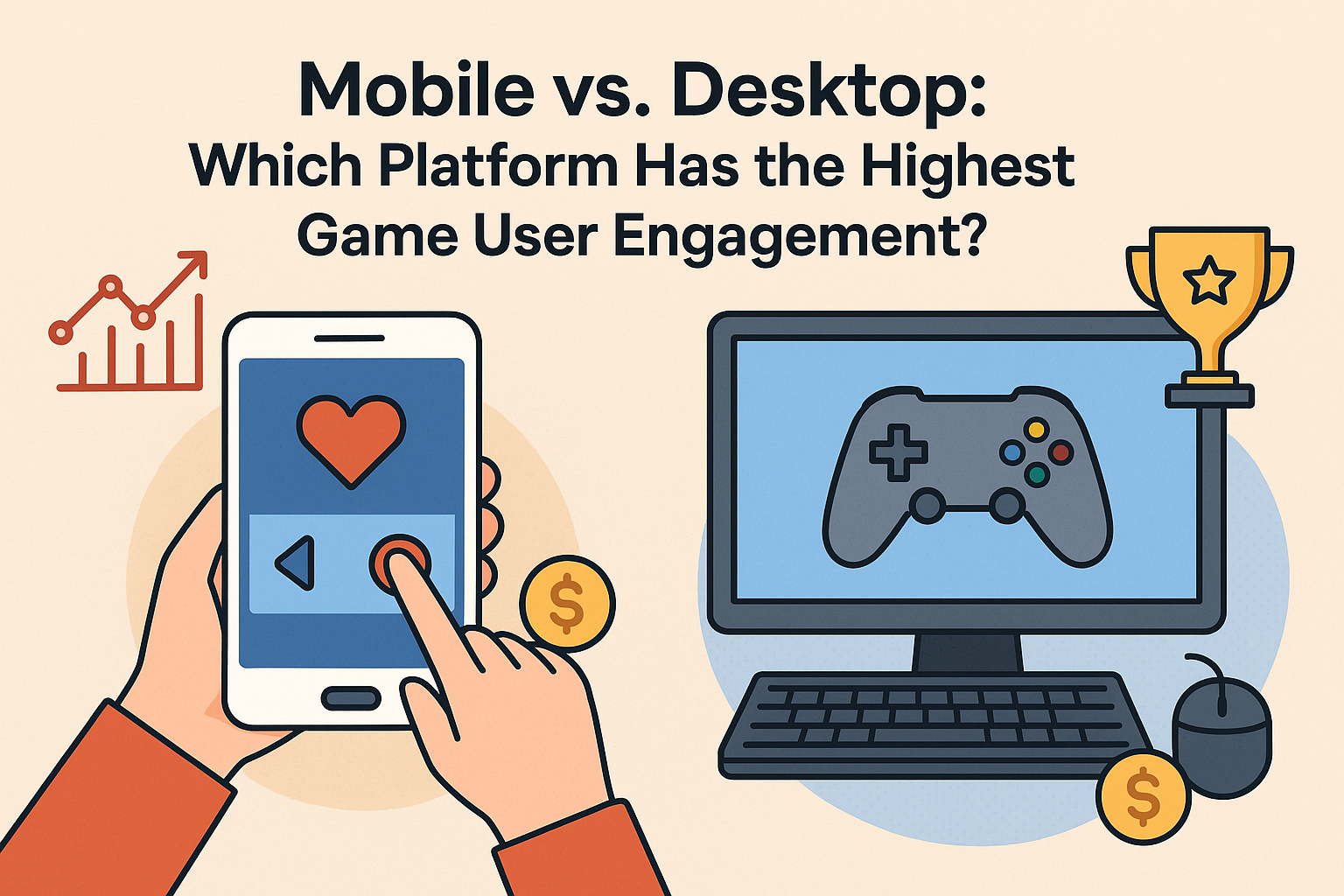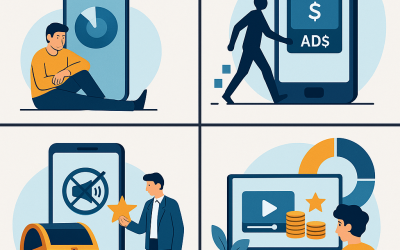Mobile vs. Desktop: Which Platform Has the Highest Game User Engagement?
Gaming has evolved into one of the world’s most dynamic entertainment industries. In 2024 alone, mobile gaming generated roughly $92 billion in revenue—nearly half of the entire gaming market. With billions of players accessing games across mobile and desktop platforms, understanding where engagement runs deepest has never been more critical for developers and studios.
But here’s the thing: engagement isn’t one-size-fits-all. Mobile and desktop platforms attract fundamentally different player behaviors, monetization opportunities, and loyalty patterns. So which platform truly delivers the highest user engagement? Let’s dive into the data.
Contents
What We Mean by “Engagement”
Before we compare platforms, let’s clarify what engagement actually means in gaming. It’s more than just downloads or active users—it’s about the quality and depth of player interaction. Key engagement metrics include:
Time spent — How long do players stay in each session, and what’s their total daily playtime?
Session frequency — How often do players return throughout the day or week?
Retention — What percentage of users are still playing after one day, seven days, or thirty days?
Monetization — How effectively does engagement translate into revenue through purchases, subscriptions, or advertising?
For free-to-play games especially, these metrics determine success. High daily active users (DAUs) and repeat play fuel advertising revenue and in-app purchases. Engaged players are more likely to convert into paying customers and stick around longer, dramatically reducing acquisition costs.
Mobile Gaming: Accessibility Meets Frequency
The Power of Being Everywhere
Mobile gaming’s greatest strength is its ubiquity. With smartphones in nearly every pocket, mobile games reached 3.2 billion active players in 2024—a number expected to hit 3.5 billion by 2025. This massive scale comes from mobile gaming’s accessibility: free-to-play models, instant downloads, and the ability to play anywhere, anytime.
Session patterns reveal mobile gaming’s “snackable” nature. The average mobile gaming session lasts just 4–10 minutes, with daily playtime typically ranging from 15–48 minutes spread across 2–6 sessions per day. These bite-sized sessions fit perfectly into busy lifestyles—a quick match during a commute, a puzzle while waiting for coffee, or a few rounds before bed.
Who’s Playing?
Generational data shows mobile is the platform of choice for younger audiences. An impressive 77% of Gen Z and 73% of millennials identify as mobile-first gamers. But it’s not just young people—54% of Gen X and 34% of baby boomers are also turning to mobile gaming. This broad demographic adoption is a major factor in mobile’s staggering DAU numbers.
 Monetization: Ads and Microtransactions
Monetization: Ads and Microtransactions
Mobile games predominantly monetize through in-app purchases and advertising. In 2024, the United States alone generated $52 billion in mobile game revenue, with China ($25 billion) and Japan ($16 billion) following closely behind.
Here’s where mobile gaming shows its unique character: casual players prefer watching ads over paying cash. A remarkable 74% of U.S. mobile gamers are willing to watch video ads for in-game content, and 82% prefer ad-supported games over paid titles. The average revenue per user (ARPU) for U.S. mobile gamers sits around $60.58, projected to reach $65 by 2029.
Rewarded video ads have become mobile gaming’s secret weapon. These ads offer players in-game currency or power-ups in exchange for watching a short advertisement, creating a win-win scenario. The numbers are compelling:
- Players exposed to a rewarded ad during their first week show a 53% retention rate—over 300% higher than average
- Players who engage with rewarded ads are four times more likely to make an in-app purchase
- Studios report revenue lifts of 20–40% after integrating rewarded videos
- eCPM rates for rewarded ads range from $10 to $50 per thousand impressions in premium regions
- 97% of top mobile games now integrate rewarded video ads
- 68% of gamers prefer rewarded ads to direct purchases
- Publishers attribute 30–60% of their ad revenue to rewarded videos
The Challenges
Despite explosive growth, mobile gaming faces hurdles. Monetization per user remains modest—ARPU increased from just $1.20 in 2021 to $2.00 in 2025, reflecting relatively small spending for most players. The market is intensely competitive, with over 49.6 billion mobile game downloads in 2024. Retention is a constant battle; players churn quickly without compelling content updates or engaging social features.
Desktop Gaming: Depth Over Breadth
The Immersive Experience
Desktop and PC gaming cater to “core” gamers seeking deep, immersive experiences—think esports titles, MMORPGs, and complex strategy games. The engagement numbers tell a different story than mobile:
Global PC gamers spend about 8.45 hours per week gaming, or roughly 1.2 hours per day. U.S. players average 7.71 hours weekly, while Chinese gamers clock in at 12.39 hours per week. Individual sessions are substantially longer too, with adult players often spending 1–4 hours per gaming session.
This depth creates strong community bonds and high lifetime value. Players aren’t just passing time—they’re investing in worlds, building skills, and forming lasting connections.
A Different Demographic
PC gaming skews toward different age groups than mobile. Younger players aged 18–24 average around 12 hours per week, while players over 45 average 5 hours weekly. The platform also demonstrates remarkable loyalty: 67% of Steam playtime is spent on titles older than six years, showing players stick with established favorites for the long haul.
While the PC gaming audience is smaller—an estimated 1.86 billion players worldwide—it’s far more committed.
Premium Monetization
Desktop games primarily monetize through premium purchases, expansion packs, and in-game cosmetics. Because players invest significantly more time, they’re often willing to pay higher amounts. The data backs this up: average revenue per user is 67% higher on console than mobile, a trend that extends to PC games with similar pricing structures.
Many PC titles adopt a games-as-a-service model, selling battle passes or cosmetic items that generate ongoing revenue. Esports and streaming further extend engagement and encourage spending on peripherals and merchandise.
The Advertising Question
Advertising revenues on desktop lag behind mobile because core gamers often pay to avoid ads. However, HTML5 and WebGL games accessible via browsers are changing the landscape. The HTML5 games market is projected to reach $3.09 billion by 2028, and these web games support cross-platform play and easy updates.
Monetization through video ads—including rewarded ads—is increasingly feasible thanks to platforms like Google’s ad placement API. While rewarded ads on desktop may not match mobile’s performance, they’re catching up as more WebGL games integrate these units.
Head-to-Head: Mobile vs. Desktop Monetization
The choice between platforms ultimately depends on your revenue goals and target player behavior.
Mobile offers:
- Massive reach with billions of users and high DAU numbers
- Frequent engagement with multiple short sessions daily
- Strong ad revenue with high eCPM rates ($10–$50) for rewarded videos
- An audience willing to watch ads (74% of U.S. mobile gamers)
- Lower ARPU at $2–$60 depending on region
Desktop/PC offers:
- Deeper engagement with sessions lasting 1–4 hours
- Weekly playtimes exceeding 8 hours on average
- Higher ARPU—67% higher than mobile due to premium pricing
- Committed players who invest in hardware, expansions, and long-term play
- Lower ad revenues, though growing through HTML5/WebGL games
For advertising specifically, mobile still leads because video ads integrate seamlessly into short sessions and deliver strong CPM rates. PC advertising is growing but remains a smaller opportunity.
So, Which Platform Wins?
Here’s the truth: there’s no definitive winner because engagement manifests differently on each platform.
Mobile gaming delivers massive scale. It reaches billions of users, generates high DAUs, and enables frequent touchpoints throughout the day. Players willingly watch ads, making it ideal for ad-driven monetization and casual experiences. However, ARPU remains modest, and users churn quickly without constant content updates.
Desktop gaming fosters deeper engagement. It attracts fewer but more dedicated players who invest substantial time and money. Long sessions, high ARPU, and strong loyalty drive revenue through premium purchases and in-game cosmetics. Advertising opportunities are smaller but growing through HTML5 and WebGL games with cross-platform play.
The Hybrid Strategy: Best of Both Worlds
The smartest approach isn’t choosing one platform over the other—it’s embracing both.
A hybrid strategy allows developers to tap into mobile’s unprecedented scale while leveraging desktop’s high-value users. Porting mobile titles to PC or console can yield significant additional revenue since ARPU is 67% higher on those platforms. The key is ensuring seamless cross-platform progression, integrating rewarded video ads tailored to each platform’s context, and continuously delivering fresh content to retain players.
Consider the implementation details: short, skippable ads work best on mobile, while longer display or interactive ads may suit PC audiences. Cross-platform play ensures players can continue their progress across devices, maximizing lifetime value.
Maximizing Engagement with AppLixir Monetization
The question isn’t which platform has higher engagement—it’s how to optimize engagement across all platforms. By understanding the unique strengths of mobile’s accessibility and desktop’s depth, developers can craft experiences that resonate with casual players grabbing a quick match and hardcore gamers settling in for an epic session.
In the end, the platform with the highest engagement is the one where your players are—and increasingly, they’re everywhere.
If you’re looking to implement a robust monetization strategy across platforms, AppLixir provides the tools to make it happen. Specializing in rewarded video ads for both mobile and desktop games, AppLixir helps developers unlock the full potential of cross-platform engagement. Their platform makes it simple to integrate rewarded ads that boost retention, increase session time, and drive revenue—whether your players are on mobile devices or desktop browsers. With proven results showing that rewarded ads can increase retention by over 300% and drive significant revenue lifts, AppLixir empowers developers to create win-win experiences where players earn rewards and studios maximize monetization. Ready to elevate your game’s engagement? AppLixir has the solution
As gaming continues to evolve, the line between mobile and desktop is blurring. Cloud gaming, cross-platform progression, and sophisticated monetization tools are making it easier than ever to serve players wherever they are.



